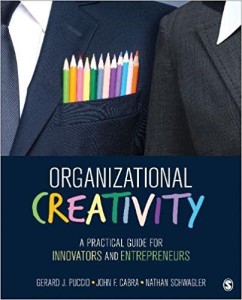Organizational Creativity, A Practical Guide for Innovators & Entrepreneurs
I read the literature associated with creativity and innovation. Can you hear me snoring? I don’t review most of them because I’d have to pan them. They are consistently boring, dry, and wonky. At the end of the day many books in the genre are, weirdly, not very creative.
I’m happy to report that I’ve read a new creativity book that is quite dynamic.
Organizational Creativity, A Practical Guide for Innovators & Entrepreneurs, by Gerard Puccio, John F. Cabra and Nathan Schwagler* is a breath of fresh air. It’s dense with fascinating and fresh information about innovation. As claimed in the title, it really is practical, and indeed, it is a lovely guide for real world work. Clearly, this is a book that was written with actual usage by real life entrepreneurs and innovators in mind. If you are interested in organizational creativity I’d be hard pressed to suggest a better book. Here’s why I think so:
- It’s current. The examples used in the book aren’t the same old case studies, and they’re spot on for the points being made.
- It’s creative, in the artistic sense. Love the Salvador Dali illustrations, the book has a story-ish arc, the examples and case studies are fun to read.
- It’s truly practical. If you’re a business leader and innovator you learn what you need to know to be more creatively effective.
- It’s accurate. As academic writers the authors have paid close attention to citing the research to back up their ideas and information. This book dispels myths.
- It’s deep. Not many books get into the details of things like “conceptual combinations.” This book goes beyond being a primer; this is advanced content.
- It’s easy to read. This is a textbook, but it doesn’t act like it, it flows nicely.
- It’s designed for actual learning. They use a Knowing-Doing-Being learning model in every chapter. Readers can integrate information immediately.
The definition of creativity is sometimes put as “novelty that’s useful.” By that definition, Organizational Creativity is creative. The combination of the above listed factors make for a new approach that is highly useful for the target reader. Potentially, this book is used not only in creativity and entrepreneurship/innovation courses, but also leadership. The tools and ways of being suggested by the book are foundational to effective leadership. This book feels more personal than it’s academic title. It feels like it’s written for you — as a person. That tone is hard to find in a textbook.
Overall, this is just well done.
My nitpicks are few. I would have wished for even more visuals and for a full color book, but I understand keeping color out makes the book more affordable. The books orientation towards an individual means that you have to figure out how to apply the learning beyond yourself — that is, to those organizations you create, lead, or manage. That direction is less explicit in this book, but it’s there. My final nitpick is that mundane thing, price. At 58.98 it’s fair to say this is a pricey book. It’s worth it — you could build an entire course around it — but I’m hoping they can bring that price down over time.
So, pick up this book and settle in with a nice glass of wine, or a notebook and pen, you will learn. And that’s a good thing.
*************************
*Full disclosure, I know all three authors fairly well, and I consider them colleagues. I’ve collaborated directly with Puccio and Schwagler on actual innovation projects or presentations. Having said that, these ties go back years and I do not have a current business relationship with any of them. We are all colleagues and leaders at the annual Creative Problem Solving Institute conference (aka “Cipsee”) — see: www.cpsiconference.com




One response to “Organizational Creativity, A Practical Guide for Innovators & Entrepreneurs”
[…] Organizational Creativity, A Practical Guide for Innovators & Entrepreneurs Gregg Fraley Blogg […]